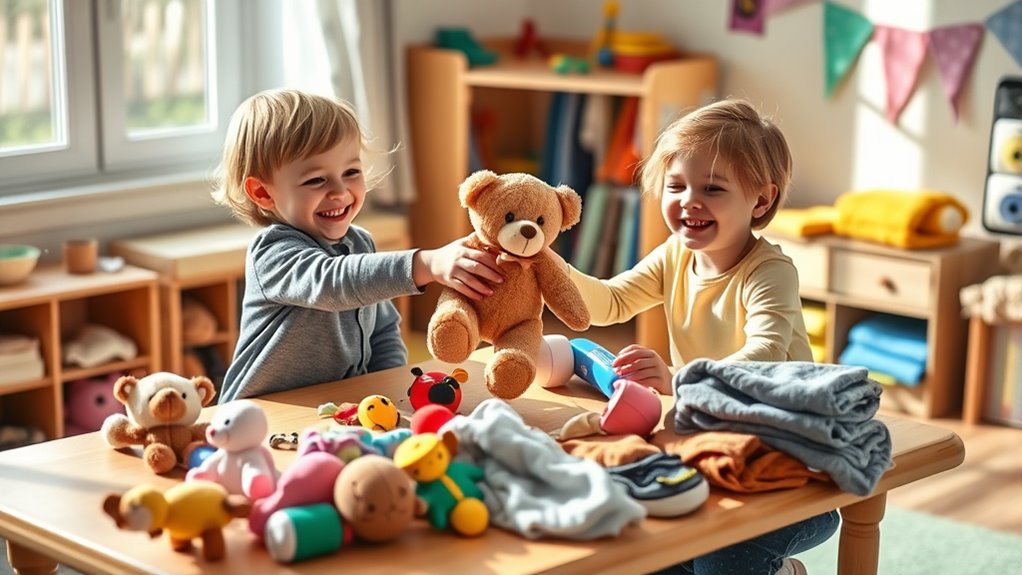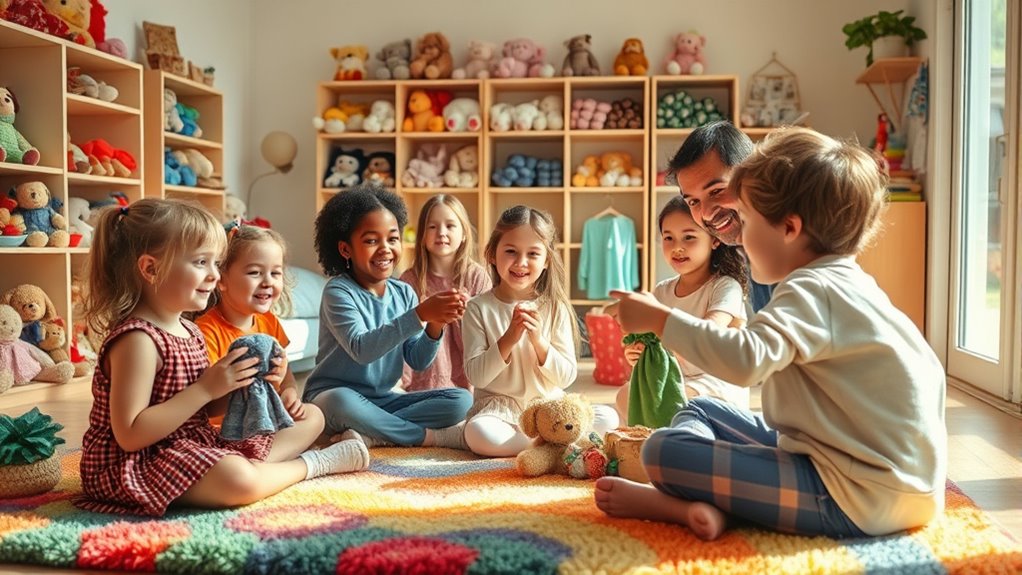Encouraging your kids to share old toys and clothes helps them learn kindness, empathy, and social responsibility. By involving them in selecting items to donate, you make the process meaningful and fun. Explaining how sharing benefits others builds their understanding and pride. Praising their efforts fosters confidence and positive behavior. Remember to respect boundaries and emphasize respect for others’ needs. Keep exploring ways to nurture generosity, and you’ll discover even more impactful methods ahead.
Key Takeaways
- Involve children in selecting which toys and clothes to donate to foster ownership and meaningful engagement.
- Explain how sharing benefits others and creates positive impacts to promote empathy and motivation.
- Use positive reinforcement and praise to encourage ongoing sharing and reinforce generous behavior.
- Teach respectful boundaries to help children share responsibly without feeling pressured or uncomfortable.
- Highlight the joy and pride children can feel by helping others, fostering gratitude and social awareness.

Encouraging kids to share their old toys and clothes teaches them important lessons about generosity and empathy. When you guide your children to give away items they no longer use, you’re helping them understand the value of kindness and community. The benefits of sharing extend beyond just decluttering; they foster a sense of compassion and social awareness that will serve them well throughout their lives. As they see how their actions can positively impact others, they begin to develop a deeper understanding of what it means to be empathetic. Sharing teaches kids to see things from someone else’s perspective, helping them recognize the feelings and needs of others. This emotional awareness is *vital* for nurturing well-rounded, compassionate individuals.
By involving your children in donating their old toys and clothes, you’re creating opportunities for meaningful conversations about kindness and generosity. When they realize that their unused items can bring joy to someone else, they start to appreciate the importance of giving without expecting anything in return. This process helps them internalize the idea that what they have can make a difference in someone else’s life. It also teaches humility and gratitude—values that are essential for developing empathy. As they observe others benefiting from their generosity, they begin to feel a sense of pride and fulfillment, reinforcing positive behavior.
Encouraging sharing also helps children understand the concept of community and interconnectedness. They learn that helping others is a way of building stronger relationships and creating a more caring environment. You can make this experience fun and engaging by involving them in choosing which items to donate and explaining how those items will be appreciated by others. This involvement makes the act of sharing more meaningful and memorable. Additionally, praising their efforts and emphasizing the positive impact of their generosity boosts their confidence and motivates them to share more willingly in the future. Developing healthy boundaries around what to share and how to do so can also promote respect for their personal space and autonomy, making the sharing process respectful and balanced.
Frequently Asked Questions
How Can I Motivate My Child to Share Without Feeling Forced?
You can motivate your child to share without feeling forced by using positive reinforcement, praising them when they do share, and showing appreciation. Set clear boundaries about what’s okay to share and what isn’t, so they feel secure. Encourage empathy by discussing how sharing helps others feel happy. By consistently combining praise with gentle boundaries, you’ll help your child develop a natural, voluntary willingness to share.
What Are Safe Ways to Clean and Sanitize Old Toys and Clothes?
You should start with toy disinfecting by washing plastic toys with warm, soapy water and disinfecting with a child-safe solution like diluted bleach or white vinegar. For clothing sanitization, wash clothes in hot water with a gentle detergent. Always check labels for care instructions. Air dry or tumble dry thoroughly. These safe methods help eliminate germs, ensuring your child’s toys and clothes are clean and safe for sharing.
How Do I Handle My Child’s Attachment to Specific Toys or Clothes?
You can handle your child’s emotional attachment by gently acknowledging their feelings and offering shift strategies. Encourage them to talk about why they cherish certain toys or clothes, then suggest creating a special keepsake or memory book. Gradually introduce new or different items, emphasizing their fun or comfort. Be patient and consistent, helping your child feel secure while gently guiding them through the progression.
Are There Cultural Considerations When Encouraging Sharing Among Kids?
Think of cultural norms as a delicate dance, guiding how kids share and connect. When encouraging sharing, you must respect their cultural background and sharing etiquette, which can vary widely. Some cultures emphasize collective well-being, making sharing more natural, while others prioritize individual ownership. By understanding these differences, you help your child navigate sharing in a way that honors their values, fostering respect and empathy across diverse cultural landscapes.
What Activities Can Reinforce the Importance of Sharing With Peers?
You can reinforce sharing by organizing group games that require taking turns and cooperating, like relay races or team puzzles. Storytelling sessions where kids share stories or objects from their own lives help illustrate the value of sharing and listening. These activities engage children actively, teaching them the importance of generosity and teamwork naturally. Consistent participation in such activities builds their understanding of sharing as a positive, rewarding part of social interactions.
Conclusion
Encouraging your kids to share their old toys and clothes not only teaches generosity but also helps reduce waste. Did you know that nearly 80% of donated items in the U.S. go to families in need? By involving your children in giving, you’re instilling kindness and environmental awareness. Keep reminding them that sharing creates happier communities and a healthier planet. Plus, they’ll feel great knowing their old belongings can make a difference in someone else’s life.









